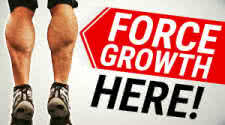Stubborn Calves: Quick Calf Training Tips to Get Them to Finally Grow

A Balanced Physique is a Complete Body Building Package
Most of the articles out there today in muscle magazines claim that the calves are stubborn and therefore need to be
worked harder. On the other hand, you can also read that some sources advise a lower number of sets for calf training,
can this be effective to get the calves to grow?
For someone with calves of relatively low fiber-density that are also high on the lower leg, inducing large degrees
of growth will undoubtedly prove impossible. But the same is true for someone whose biceps are short and of low fiber-
density. Many have written that calves are stubborn or less responsive to exercise than other muscles because they
receive so much more exercise by comparison.
Calves are unavoidably involved in such daily activities as walking, running and climbing. These same people go on to
conclude that the calf muscles therefore require harder work.
I don't believe that calves are any more resistant to growth than any of the other skeletal muscles. Growth beyond
normal levels seems agonizingly slow even to the genetically gifted. And even if many bodybuilders' calves do respond
slower than the rest of their muscles, it doesn't logically follow that they should be trained any harder. All muscles
respond optimally when training intensity is maximal, i.e., each set is carried to a point of momentary muscular
failure.
What is usually meant by "training calves harder" is to train them longer with more sets. A common mistake is to
confuse harder with longer. In fact, training harder and training longer are mutually exclusive. Either you train
hard or you train long. You can't do both. A similar situation exists with running. If you're going to run a mile,
you don't start out by sprinting. You pace yourself. No one can sprint for a mile. Likewise, no one can train hard
for much more than 20 or 30 minutes.
My recommendation is that you work calves no more than twice a week following your thigh training. Perform no more
than two sets of standing calf raises and one set of seated calf raises. Perform each rep through a full range of
motion, stretching at the bottom and contracting maximally at the top. Choose a weight for each set that allows for
the strict performance of 10 reps, adding 10 percent when the same weight allows for 15 reps.